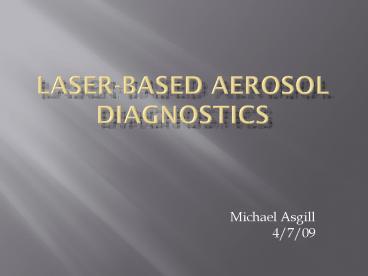Michael Asgill - PowerPoint PPT Presentation
1 / 26
Title:
Michael Asgill
Description:
In conjunction with other aerosol diagnostic devices to make a measurement (SMPS) ... Ingle, J.D. and Crouch, S.R. Spectrochemical Analysis, (1988) Prentice Hall, ... – PowerPoint PPT presentation
Number of Views:35
Avg rating:3.0/5.0
Title: Michael Asgill
1
Laser-Based Aerosol Diagnostics
- Michael Asgill
- 4/7/09
2
Why Laser-Based?
- Fast, real-time response
- Qualitative and Quantitative data
- Little to no preparation
- Non-invasive
- Major , minor, and trace species analysis
- Solids, liquids and gases
- Composition and size measurements
3
Uses
- In conjunction with other aerosol diagnostic
devices to make a measurement (SMPS) - After use of other devices, like impactor, to
gain additional information - Stand-alone system
4
Optical Properties?
- Max Planck (1900) - Photon is basic unit of
light - h Plancks constant
- ? frequency
- c speed of light
- ? wavelength of light
5
What Exactly is Measured?
- Most measure the energy state of atoms/molecules
(exception elastic light scattering methods) - Three states
- Electrical
- Orbital level of electrons
- Near IR to UV
- Vibrational
- Oscillatory motion of molecules
- IR
- Rotational
- Microwave
6
What is Measured Contd
Electrical, Vibrational and Rotational Energy
States1
Vibrational Energy States1
7
What is Measured Contd
- Signal is proportional to atomic/mass
concentration - Attain dp with known density
- Signal attained from one of four methods
- Absorption
- Fluorescence
- Emission
- Scattering
Vibrational Energy Modes1
8
Calibration
- Must calibrate signal
- Use known concentrations of aerosols to make a
calibration curve - Standards to match bulk of sample
- Matrix effects
Example Calibration Curve
9
Aerosol Introduction
- Aerosol created or flowed into system
- Dried by co-flow of gas
- Dry aerosol excited/volatized
- Excited aerosol emits light
Aerosol Introduction1
10
Absorption
- Incident Radiation is at the sample absorption
frequency - Requires knowledge of aerosol
- Breakdown of aerosol by atomizer (flame)
- Loss of aerosol
Absorption of Light by Sample1
11
Absorption Contd
Absorption Measurement Setup1
- Requires calibration of signal in relation to
atomizer - Record values for flame, blank, and aerosol
12
Fluorescence
- Incident radiation usually same frequency as
aerosol absorption - Spontaneous emission distributed uniformly in
space. - Low signal output because only faction of FL can
be captured by detector - Lose aerosol
Fluorescence (Luminescence)1
13
Fluorescence Contd
- Four possibilities
- Resonant
- Stokes/Anti-Stokes
- Sensitized
- Multi-photon
Types of Flourescence1
14
Emission
- Excitation of aerosol at any wavelength
- Emission along atomic (electrical) lines
- Tells atomic composition of aerosol
Emission Signal
15
Infrared Spectroscopy (IR)
- Differentiate between bonds present in aerosol
- Uses differences in vibrational states
- Absorption or Emission
- Must be IR active
- Shift in dipole moment of molecule during
vibration - N O bond vs. O O bond
- Signal orders of magnitude less than atomic
(electronic) emission
16
Elastic Scattering
- Elastic outgoing radiation is same wavelength as
incoming - Two theoretical models
- Rayleigh Scattering small, non-absorbing,
spherical particles (altlt1, ma ltlt1) - Mie Scattering no size or shape limitation,
absorbing and non-absorbing - Mie solution converges on Rayleigh solution as
particle size decreases.
17
Elastic Scattering Contd
- Intensity of scattered light dependent on
scattering angle and particle size - Optical Particle Counter (OPC)
Rayleigh Solution
Light Scattering Geometry2
i1,i2 f(?)
Mie Solution
18
Inelastic Scattering (Raman)
- Molecular spectroscopy method
- Similar to IR spectroscopy but no absorption,
only scattering. - Signal proportional to mass density
- Electric field of molecules perturbed at
frequency of incoming electromagnetic (EM) wave. - Most of perturbation elastic but chance EM wave
will impart some of its energy to the molecule
Analogy of Raman Scattering3
19
Raman Scattering Contd
- Mathematically, Raman Scattering is Explained by
the equations below - Three distinct frequencies, ?0, ?0?vib
(Anti-Stokes), ?0-?vib (Stokes) - Requires change in polarizability to be non-zero
20
Issues
- Detection Limit minimum concentration that can
be detected optically - Signal Saturation incomplete vaporization
- Matrix effects localized vs. bulk plasma
properties
21
Detection Limit
Signal-to-Noise vs. Concentration
Typical Emission Spectrum
22
Signal Saturation
- Incomplete vaporization due to heat and mass
transfer time scales
Signal vs. volume4
23
Matrix Effects
- More prominent in multi-component aerosols
- Can have different signal strength of a signal
for the same concentration if in presence of
different elements - Differences in density, heat capacity, thermal
conductivity, etc. cause different localized
temperatures - Rate of dissociation (electron density)
proportional to temperature
24
Instrumentation (LIBS)
- LASER
- Light Amplification by Stimulated Emission of
Radiation - Pulsed (ns-fs)
- NdYag (1064 nm)
- Back Scatter of Light
- Fiber Optic
- Spectrometer
- Disperses light
- Charged Coupled Device (CCD)
- Light to electrical signal
Sample Setup
25
Conclusion
- Why Laser-Based Diagnosis
- Energy states of a molecule/atom
- Electrical, vibrational, rotational
- Aerosol introduction
- Four different signals can measure
- Absorption, fluorescence, emission, scattering
- Issues with Laser-Based techniques
- Detection limit, saturation, matrix effects
- Instrumentation
26
References
- Ingle, J.D. and Crouch, S.R. Spectrochemical
Analysis, (1988) Prentice Hall, Englewood Cliffs,
NJ - Hahn, D.W. Light Scattering Theory, (2004)
http//plaza.ufl.edu/dwhahn/Rayleigh20and20Mie2
0Light20Scattering.pdf - Hahn, D.W. Raman Scattering Theory, (2007)
http//plaza.ufl.edu/dwhahn/Raman20Scattering20T
heory.pdf - Carranza, J.E. and Hahn, D.W., Spectrochimica
Acta Part B, 57 (2002a) 779-790 - Windom, B. Laser Induced Breakdown Spectroscopy
(LIBS) for Aerosol Characterization, (2007)

